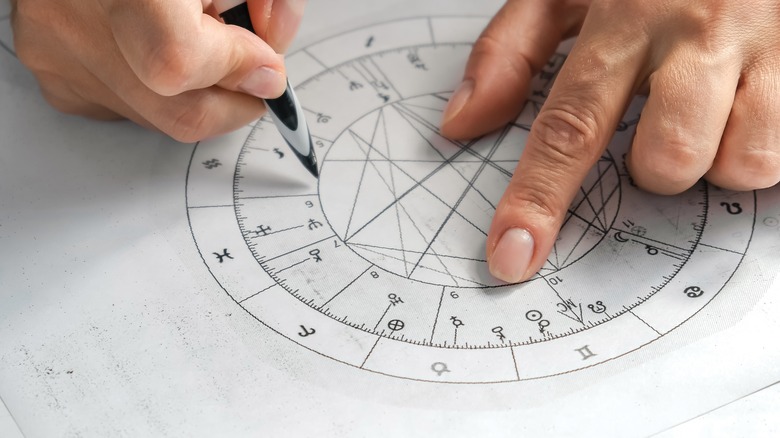Seeing Retrograde Planets In Your Astrological Chart Is A Sign To Focus
Even if you're a complete newbie to the world of astrology, there's a high chance you've heard the term "retrograde" tossed around in casual conversation. Mercury in retrograde, in particular, is a fairly common phenomenon that some people use as an explanation for everything from delays in travel to the sudden urge to text your ex. While this astrological weather is the retrograde that's most frequently discussed, retrogrades can apply to any planet during their appointed cycles, meaning your birth chart — the exact map of the sky when you were born — could feature planets in this state.
Thankfully, placements in retrograde are nothing to panic about. Just about everyone has a few areas or placements in their chart that are a bit more challenging or require more of a direct focus than others, and planets in retrograde fall into this category. By learning more about your specific chart and what areas are affected by retrogrades, you can get a better idea of how these themes present themselves throughout your life and how you can work with them to keep everything running smoothly.
How do retrogrades work?
Retrogrades are an astrological and astronomical phenomenon that gives the appearance that a planet is moving backward from our view on Earth. These planets aren't actually suddenly choosing to change their path, but to astrologers in the past that had yet to gain our modern knowledge of the motion of the planets, this phenomenon was a pretty big deal. As such, this natural occurrence carries a fairly heavy astrological weight, though the true scientific explanation is a bit less mystical in nature.
A planet that appears to stop and reverse direction in the night sky is actually just traveling at a slower speed in its orbit than Earth. Typically, planets in the sky appear to move from west to east, but when a planet reaches a point in its orbit where we're moving faster, it creates an optical illusion. To astronomers, this is called apparent retrograde motion, thanks to the fact that these planets only appear to move backward and aren't actually doing so. Astrologers, however, typically just refer to it as a planet being in retrograde to keep things simple.
How to tell if you have planets in retrograde in your chart
If you're interested in astrology, it's likely that you've either used an app or an online tool to generate your astrological birth chart at some point. These online-generated charts typically focus on placements and houses, revealing important information like what your sun, moon, and rising signs are and where they sit on the wheel that is your chart. Simplistic versions of your chart give you a solid base to start learning without overwhelming you with a flurry of symbols and lines right off the bat, but they also often exclude other factors that could impact those placements, including retrogrades.
To glean more information, head over to a website that promises a fuller picture of your birth chart — popular, free choices include Cafe Astrology and Astrodienst, though there are plenty of options available. After entering your birth date, time, and location, the website you choose will draw up your custom chart. To find planets in retrograde, simply look for an "R" or an "Rx" next to the listed placements.
Retrograde planets can symbolize areas where you need to pay special attention
Planets in retrograde astronomically are all about reversals and the appearance of moving backward. Astrologically, retrogrades bring the same energy — just more symbolically. Retrograde placements in your birth chart can represent areas where the energy is more inward-focused or private, or areas where you were lacking something in your past. Take, for example, Saturn in retrograde. Saturn is representative of authority and rules, so someone with this retrograde placement might have a hard time falling in line and listening to instruction, or they could have had issues surrounding parental authority as a child — either an incredibly lax upbringing or ultra-strict parents.
Retrograde planets aren't a rare phenomenon — it's likely that you'll have at least one retrograde placement in your chart — but they can still present a few challenges with the energy of that placement. That being said, these placements aren't the end of the world. By giving your retrograde planets a bit more of your focus, you can work through these issues and develop a healthier approach to the impacted area of your life.
How to balance the energy of retrograde placements
Because retrogrades leave you with a lack of something or provide a more hidden expression of the placement they affect, the remedy is to give these areas of your life more of a spotlight to create some balance. This can be difficult, as retrograde areas tend to bring about feelings of shame and embarrassment, but exposure therapy is the best way to push through. Begin small and directly confront your thoughts in this area of life by getting started on your journaling journey or encouraging a more focused internal dialogue; once you feel more confident, share these thoughts with a close friend or make a marked effort to face your fears.
If you have Uranus retrograde in your birth chart, for example, you could have a difficult time expressing yourself or being bold enough to go against the grain. Start by analyzing where this fear comes from — were you discouraged from self-expression in childhood? Have you consistently felt like your ideas were too "out there" to share? Once you've figured out your personal connection to this placement, put in the effort to push through that block in your daily life. By doing so, you'll be able to better round out your experience and face any concerns these placements might cause.




